How to Grow a Lemon Tree from Seed: A Step-by-Step Guide for Beginners
- September 26, 2024
- 0 comment
Lemon trees are a delightful addition to any garden or indoor space, offering fragrant blossoms and vibrant, tangy fruits. If you’ve ever wondered how to grow a lemon tree from seed, it’s a rewarding project that combines patience, dedication, and the satisfaction of nurturing a plant from its earliest stages.

While growing lemon trees from seeds may take longer to produce fruit compared to other methods, the journey is both exciting and fulfilling. Watching your tree sprout and thrive creates a personal connection and brings a sense of accomplishment to your gardening experience.
List of How to Grow a Lemon Tree from Seed
- Choosing the Right Lemon
- Extracting and Preparing the Seeds
- Pre-Germination Process
- Planting the Germinated Seeds
- Positioning and Light
- Watering and Care
- Transplanting Your Seedling
- Fertilizing Your Lemon Tree
- Pruning and Shaping
- Patience and Long-Term Care
Choosing the Right Lemon
The first step in growing a lemon tree from seed is selecting the right lemon. Always opt for a fresh, organic lemon, as non-organic ones are often treated with chemicals that may prevent the seeds from germinating. Popular choices like Eureka or Meyer lemons are ideal for home gardeners, as they are known for their adaptability and flavorful fruit.
Tip: Choose a fully ripe lemon for the best results. Ripe lemons typically have larger, healthier seeds that increase the chances of successful germination.
Extracting and Preparing the Seeds
Once you’ve chosen a lemon, it’s time to extract the seeds. Follow these steps:

- Cut the Lemon: Use a sharp knife to slice the lemon carefully, ensuring you don’t damage the seeds.
- Extract the Seeds: Gently remove multiple seeds, as not all will germinate. Having extras increases your chances of success.
- Rinse the Seeds: Thoroughly rinse the seeds under cool water to remove any leftover pulp. Residual pulp can promote mold growth during germination.
- Peel the Seed Coat (Optional): For faster germination, you can carefully peel off the outer coating of the seed, known as the seed coat. While this step isn’t required, it may help the seeds sprout more quickly. Take care not to damage the delicate seed inside.
Pre-Germination Process
Pre-germinating lemon seeds is an effective way to encourage sprouting before planting them in soil. This step jump-starts the growing process and helps ensure success. Follow these steps for pre-germination:
- Dampen a Paper Towel: Use a clean paper towel and moisten it with water. It should be damp but not dripping wet, as excessive moisture can lead to mold.
- Place the Seeds: Spread the lemon seeds evenly on the damp paper towel, leaving enough space between each seed to prevent overcrowding.
- Seal in a Plastic Bag: Place the paper towel and seeds into a plastic zip-lock bag. Seal the bag tightly to create a humid environment ideal for germination.
- Store in a Warm Place: Keep the bag in a warm, dark location, such as a cupboard or on top of a refrigerator. Check the seeds every couple of days to ensure the paper towel remains moist. Within 1 to 2 weeks, you should see small roots emerging, signaling that the seeds are ready for planting.
Planting the Germinated Seeds
Once your seeds have sprouted, they’re ready to be planted in soil. Follow these steps to ensure proper planting:
Prepare the Pot
Selecting the right pot is essential for successfully planting lemon seeds. Start with a small pot, about 3–4 inches in diameter, and ensure it has drainage holes at the bottom. These holes are crucial for preventing waterlogging, which can lead to root rot.
For the best results, use well-draining soil specifically suited for lemon trees or citrus plants. This creates the perfect environment for the seeds to grow into healthy seedlings.
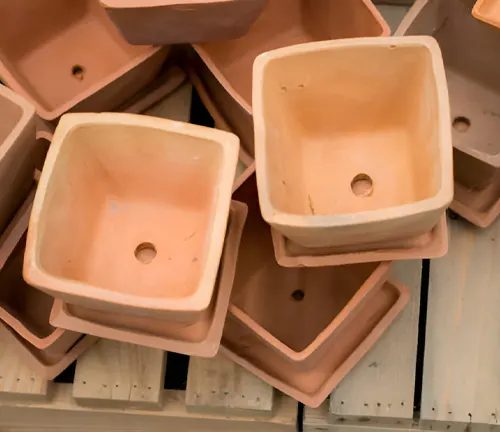
Use the Right Soil
Using the proper soil is key to growing lemon trees from seeds successfully. Opt for a light, well-draining potting mix to give the seeds the best chance to thrive. A commercial citrus potting mix is an excellent choice, as it’s specifically formulated for citrus plants. Alternatively, you can make your own by mixing regular potting soil with sand or perlite to improve drainage.
Healthy soil ensures your lemon seeds get the right balance of moisture and air, promoting strong root development and overall growth.

Plant the Seeds
To plant lemon seeds, make a small hole about ½ inch deep in the prepared soil. Gently place the sprouted seed into the hole with the root facing downward. Cover the seed lightly with soil and press it down gently to ensure good contact between the seed and the soil.
This careful planting process sets the stage for healthy growth and helps the lemon tree establish strong roots.
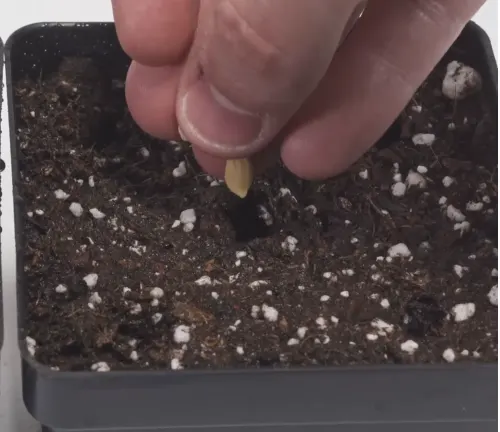
Watering
After planting, water the soil gently until it’s evenly moist. Lemon seeds require a consistently moist environment to germinate, but it’s important to avoid overwatering, as this can lead to root rot or fungal issues. Check the soil regularly to ensure it stays damp but not soggy.
Proper watering helps create the ideal conditions for your lemon seeds to sprout and thrive.
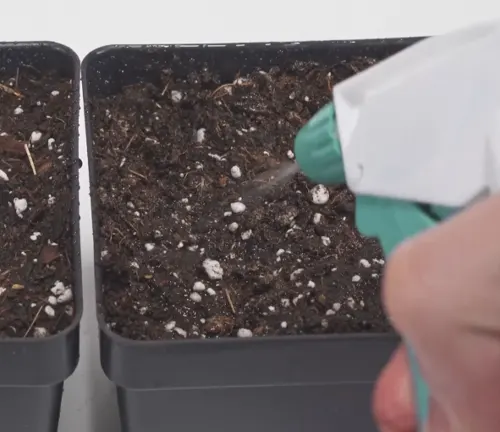
Cover with Plastic
Create a mini greenhouse to speed up germination by covering the pot with a clear plastic bag or plastic wrap. This setup helps retain moisture and warmth, which are essential for the seeds to sprout. Ensure the plastic doesn’t touch the soil directly, and poke a few small holes in it to allow for airflow and prevent mold.
This simple step creates the perfect environment for growing lemon trees from seeds, promoting faster and healthier growth.
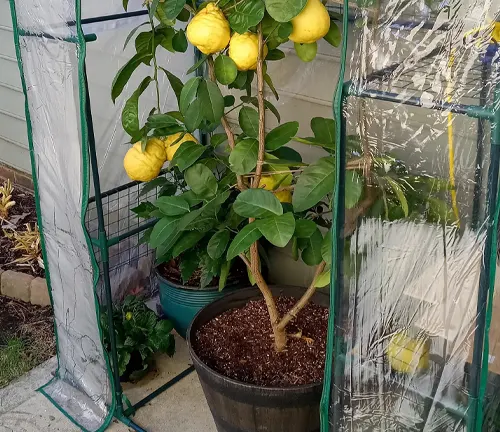
Positioning and Light
Lemon trees thrive in sunlight, so it’s crucial to position your pot in a warm, sunny location. A windowsill that receives plenty of direct sunlight is perfect. Seedlings need at least 8 hours of light daily to grow strong and healthy. If natural light is limited, consider using grow lights to supplement their light needs.
As your lemon seedlings grow, rotate the pot occasionally to ensure all sides of the plant receive equal light exposure. This simple practice encourages even growth, helping your plant develop straight and sturdy.
Watering and Care
Maintaining the right moisture balance is essential for young lemon seedlings. Lemon trees prefer moist soil but cannot tolerate waterlogging, so careful watering is key to their health. Here are some tips to keep your seedling thriving:
- Watering Schedule: Check the top inch of soil; if it feels dry, it’s time to water. Water thoroughly to ensure moisture reaches the roots, but avoid overwatering, as soggy soil can lead to root rot.
- Drainage: Ensure your pot has proper drainage holes, and never let the plant sit in standing water. Good drainage prevents waterlogging and promotes healthy root development.
- Humidity: Lemon trees flourish in slightly humid conditions. If your home is dry, use a small humidifier near the plant or mist the leaves occasionally to provide the necessary humidity.
Transplanting Your Seedling
Once your lemon seedling has grown a few inches tall and developed its first set of true leaves (the second set of leaves after the initial “seed leaves”), it’s time to transplant it into a larger pot. This step provides the growing roots with more space and ensures continued healthy development. Follow these steps:
- Choosing the Pot: Select a pot that’s 6–8 inches in diameter with proper drainage holes to prevent waterlogging.
- Transplanting: Carefully remove the seedling from its original pot, taking care not to damage the delicate roots. Place it in the new pot, ensuring it sits at the same depth as in the previous container.
- Soil Choice: Use a well-draining potting mix suitable for citrus plants. Lemon trees are highly sensitive to waterlogged conditions, making proper drainage essential.
- Watering After Transplanting: Thoroughly water the seedling immediately after transplanting to help it settle into its new environment. Resume your regular watering schedule once the soil starts to dry out.
Fertilizing Your Lemon Tree
As your lemon tree continues to grow, it will need nutrients to stay healthy. Here’s how to feed your tree:
- Citrus Fertilizer: Use a balanced fertilizer specifically designed for citrus trees. These fertilizers contain the nutrients that lemon trees need, such as nitrogen, phosphorus, and potassium, as well as micronutrients like magnesium and iron.
- Fertilizing Schedule: Fertilize your tree every 6 weeks during the growing season (spring through summer). During the winter, reduce the frequency to once every 2–3 months, as lemon trees grow more slowly in cooler months.
Pruning and Shaping
Pruning is an important part of caring for your lemon tree. Regular pruning helps the tree maintain a healthy shape and encourages new growth. Here’s how to prune your tree:
- When to Prune: Wait until your tree has developed a few sets of true leaves before you start pruning. You can begin pruning once it’s about 1 foot tall.
- How to Prune: Use sharp pruning shears to trim away any dead or damaged branches, as well as any branches that cross or rub against each other. Remove suckers (small shoots that grow at the base of the tree) to encourage upward growth.
- Shaping Your Tree: As your tree grows, continue pruning to shape it into a balanced form. This will help it grow stronger and produce more fruit in the future.
Patience and Long-Term Care
Growing a lemon tree from seed is a slow process, and it can take several years before your tree is mature enough to produce fruit. Most lemon trees grown from seed will take anywhere from 5 to 15 years to bear lemons, and there’s no guarantee that the fruit will be identical to the parent tree. However, with proper care and patience, your tree will grow into a beautiful, fragrant addition to your home or garden.
Conclusion
Growing a lemon tree from seed is a rewarding, long-term project that requires patience and dedication. By following the steps outlined above selecting the right lemon, pre-germinating the seeds, planting them in well-draining soil, and providing plenty of sunlight and water you can enjoy watching your tree grow from a tiny seedling into a full-sized tree.
Though it may take years for your lemon tree to produce fruit, the joy of nurturing a tree from seed is worth the wait. And even if your tree doesn’t bear fruit, you’ll still have a beautiful, fragrant plant to enjoy for many years to come.
Frequently Asked Questions (FAQ)
- How long does it take for a lemon tree grown from seed to produce fruit?
Lemon trees grown from seed can take anywhere from 5 to 15 years to produce fruit. However, some trees may not bear fruit at all, depending on growing conditions and whether the tree was propagated from a hybrid lemon variety. - Can I grow a lemon tree indoors?
Yes, lemon trees can be grown indoors as long as they receive plenty of sunlight, preferably 8 to 12 hours a day. Position your tree near a sunny window or use grow lights to ensure it thrives indoors. - Do I need to dry the lemon seeds before planting them?
It is not necessary to dry the seeds before planting. In fact, planting fresh seeds immediately after extracting them from the lemon may increase the chances of successful germination. - How often should I water my lemon seedling?
Lemon seedlings prefer consistently moist but not waterlogged soil. Water the seedling when the top inch of soil feels dry, but ensure the pot has good drainage to avoid root rot. - Do I need to use fertilizer for my lemon tree?
Yes, once your lemon tree begins to grow, it will benefit from regular feeding with a balanced citrus fertilizer. Fertilize every 6 weeks during the growing season and reduce feeding during the winter months. - Can I grow a lemon tree from a store-bought lemon?
Yes, you can grow a lemon tree from seeds found in store-bought lemons. However, make sure to use organic lemons, as non-organic varieties are often treated with chemicals that can inhibit seed germination. - Will a lemon tree grown from seed taste the same as the parent tree?
Lemon trees grown from seed may not produce fruit that is identical to the parent tree, especially if the seed came from a hybrid variety. The fruit could vary in taste, size, and appearance. - Can I grow multiple lemon trees from a single lemon?
Yes, a single lemon typically contains several seeds, each of which can be used to grow an individual lemon tree. However, not all seeds will germinate, so planting multiple seeds increases your chances of success. - What is the best time of year to plant lemon seeds?
Lemon seeds can be planted at any time of the year indoors. However, if planting outdoors, it’s best to start them in the spring or early summer when temperatures are warmer and more consistent. - How tall will a lemon tree grown from seed get?
Lemon trees can grow anywhere from 10 to 20 feet tall when grown outdoors in ideal conditions. However, indoor lemon trees typically stay smaller, around 3 to 6 feet tall, especially if they are regularly pruned.

Kristine Moore
Forestry AuthorI'm Kristine Moore, a seasoned garden landscaping professional with over 30 years of experience. My extensive career has been dedicated to transforming outdoor spaces into stunning, sustainable landscapes. With a deep understanding of horticulture, design principles, and environmental stewardship, I have become a respected figure in the field, known for creating harmonious, visually appealing, and eco-friendly gardens. My commitment to excellence and continuous learning in landscaping trends and techniques has solidified my reputation as an expert in garden design and implementation.




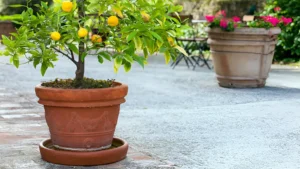








Leave your comment